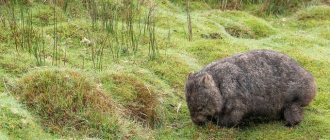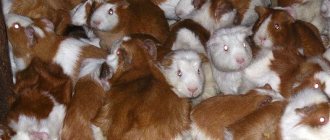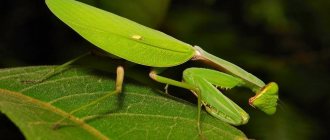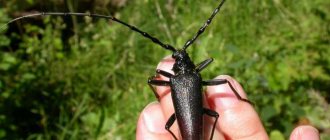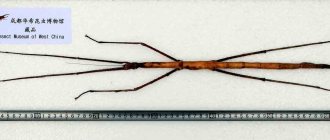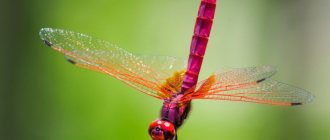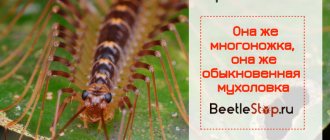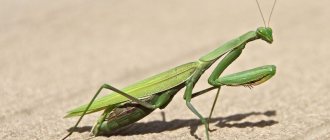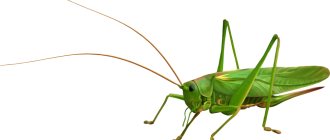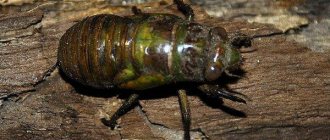How does the longhorned beetle colonize a tree?
The female, with her first pair of jaws, makes a small depression in the tree bark, then begins to deepen it and lays eggs in it. This is how wood (pine) becomes infected with the longhorn beetle. As shown in the photo.
The female lays eggs in any suitable hole in the tree, preferring peeled bark. If necessary, she bites out a nest in the wood, finding a weak spot in it. The larva, developed from an egg, has a thick soft whitish body, a small head, powerful jaws and a brutal appetite. Before pupation, the larva in our climatic conditions can eat your house for up to 5 years.
The longhorned beetle, as soon as it is born, is immediately ready to reproduce its own kind. By the way, the beetles themselves prefer to use the pistils and stamens of flowers and tree leaves as food.
The longhorned beetle chooses higher places for breeding, so it is quite difficult to detect its passages. The female lays up to 400 eggs, making holes in the tree with her jaws. The larvae hatch after 2 weeks and begin to bite into the tree at breakneck speed. Traces of their activity can be identified by paying attention to the presence of drill flour, dust or sawdust. The female lays her eggs very deeply in the tree and after approximately 2 weeks the larvae of the longhorned beetle hatch. Having hatched, the larvae begin to eat the tree at breakneck speed, making more and more new moves.
The habitat of moustached beetles is dry trees. Destroy dead wood on your plots.
Imago lifestyle
Clumsy insects with a thick body stay on the ground and crawl along stumps and herbaceous plants. Adults feed on cereals and love clover, dandelions, buttercups, anemones, and violets. If they find themselves near fields with vegetables, they damage agricultural crops. Beetles can be found in various biotypes: steppes, meadows, forest edges. To continue the life cycle, it is important to have nearby open areas suitable for solitary bees to settle.
Information. On a hot day, the beetles hide under the leaves; their soft abdomen is buried in the ground to avoid drying out.
Adults appear in spring, in April. After additional feeding they begin to mate. Beetles are slow and clumsy and do not run away from danger. Their hemolymph contains a highly toxic substance called cantharidin, which can kill small animals. When the oily liquid comes into contact with human skin, it causes an allergic reaction and blisters appear.
Interesting fact. In case of danger, the purple T-shirt falls to the ground and pretends to be dead. An additional defense mechanism is an oily, unpleasant-smelling liquid secreted from the joints of the limbs and abdomen.
In regions where the area of meadows is shrinking, construction is taking place, plowing is taking place, grass is being mowed, and the number of purple t-shirts is decreasing. Due to the lack of wings, beetles cannot move long distances in search of new habitats.
Reproduction
Mating is the finale of the life of males; after transferring the seed to the female, they die. For laying, a place is chosen close to a colony of solitary bees. The female digs a hole in soft soil. In one clutch the number of eggs reaches 1000 pieces. The female makes 2-3 separate burrows with eggs. After this, it also dies. The larvae appear after 30-40 days.
The blister family is characterized by hypermetamorphosis. This type of insect development is transitional between complete and incomplete metamorphosis. The first instar larvae, called triungulins, differ from the older instars. External differences are related to lifestyle. Triungulins are actively moving, looking for hosts for further development. Once in a bee's nest, they moult and turn into short-legged, worm-like parasites that feed on honey. Before true pupation, insects go through a “false pupae” stage.
Professionals will help you fight the longhorned beetle
To treat the external surface of a wooden house with Clipper, you can invite a specialist with a cold or hot fog generator. This treatment allows you to evenly cover the entire treated surface with drops of insecticide, spending less time on it and saving on consumables.
Be wary of the proposal to treat your house against insect pests with a combination of Clipper and Bi-58. The poisonous drug Bi-58 is a bright blue liquid containing phosphoric acid esters, which leaves irremovable stains and an ineradicable chemical odor after its use. It is strictly forbidden to use this drug for treating interior spaces.
In the market for services offered by professionals for the destruction of wood-eating insects, the following areas deserve attention:
- Fumigation with Phosphine;
- Microwave disinsection.
- XILIX GEL
These methods have their advantages and disadvantages. They can only be used by specialists who have undergone special training, confirmed by the appropriate certificate.
Ecology
Of all the abiotic factors, the main limiting environmental factor for the distribution of ground beetles is soil moisture. The vast majority of species prefer moist biotopes with low temperatures, which is due to the rapid loss of water by the body of ground beetles. This is especially true for predatory species that need to replenish their body’s water supply by directly drinking water. Phytophagous ground beetles replenish water shortages by eating plant tissues where there is enough plant sap. Some parasitoid species replenish the lack of water at the expense of the host's hemolymph. A small group of species has adapted to conserving water and is able to live in saline biotopes - the coasts of salt lakes, salt marshes, and sea beaches.
Purple ground beetle
Lebia the little crusader
XILIX® Gel fungicide and insecticide in one bottle with a 10-year guarantee!
XILIX® Gel is an innovative development for combating any wood pests such as longhorned beetles, borers, shashel, wood borers, etc. It is also an effective professional biocide that effectively destroys mold, mildew, and copes with wood rot and defects.
Indispensable for the prevention and treatment of wooden structures.
• Destroys termites, borer beetles, bark beetles, wood borers, longhorned beetles, etc. • Economical and easy to use • Safe for people • Strengthens the structure of the wood • Ready to use, the gel does not flow, leaves no traces • Penetrates deeply into the wood
XILIX® Gel is an excellent, safe alternative to phosphine gas fumigation with a 10 YEAR warranty! High efficiency is achieved thanks to properly selected gel components. Biocides and permethrin in the composition give a fantastic insecticidal and fungicidal effect.
Thanks to its thixotropic formulation, the gel works without loss of properties even in a thick layer of wood, thereby reducing the number of applications to obtain the required therapeutic or prophylactic dose of the gel.
Morphology
Imago
Most ground beetles have a similar, characteristic body shape, but some specialized groups differ significantly from the typical appearance. Their uniform morphology makes identification difficult, and confident identification of many species is only possible through dissection.
Black (shagreen) ground beetle
Most often, ground beetles are black with a metallic sheen; however, iridescence of different colors is not uncommon, and sometimes they have differently colored spots on the body. The size varies significantly from 1–2 mm to almost 10 cm. In Russia, representatives of the genus Trechus are among the smallest species. The largest in Europe are Carabus gigas and Carabus scabrosus (snail-eater), reaching 5–6 cm in length.
Crimean ground beetle - a subspecies of the species snail-eater
Head
The head is slightly flattened in the dorsal-ventral direction, has a protruding (protruded) mouthparts with well-developed crescent-shaped mandibles. The eyes are usually well developed and protruding, but in underground and cave species they are reduced or absent. The antennae are almost always filiform and consist of 11 segments. Attached between the eyes and the base of the mandibles, but closer in horses.
Head of a representative of the genus Carabus
Pronotum
The pronotum of most ground beetles has a rather characteristic shield shape with a well-defined edge. Smooth or sculptured. The posterior angles are often elongated, pointed or rounded and are an important taxonomic character.
Notiophilus rufipes from the genus Bigeyes has a head with eyes wider than the pronotum (subfamily Plotinniki)
Elytra and wings
The elytra completely cover the abdomen. Most often they are sculptured with longitudinal grooves. The spaces (between the grooves) are solid or differently dotted. Many species have fused elytra, reduced wings and cannot fly.
Forest ground beetle
Legs
The legs are long, adapted for running. The paw formula is 5-5-5. The hind coxa bisects the first ventral sternite (synapomorphy of Adephaga). The fore tibia usually has at its apex a specialized organ with comb-like setae for cleaning the antennae.
Leg of a male Loricera pilicornis
Atypical forms
Highly specialized species usually differ from the typical forms of ground beetles. For example, representatives of the tribe Cychrini specialize in hunting snails. Due to this, their head and chest are narrowed and elongated, which allows them to penetrate the snail's shell and pull it out.
Cychrus cylindricollis
Some ground beetles have developed the ability to dig. A typical example is the tribe Scaritini, which has wide and flattened tibiae with spine-like growths on the sides that help them dig.
Scarites sp.
Ground beetles from the subfamily Paussinae are myrmecophiles, adapted to coexist with ants. Many of their representatives have strongly flattened antennae and legs.
The subfamily Cicindelinae, sometimes considered a separate family, is also distinct from other ground beetles. They have large eyes, which make their heads wider than their narrow pronotum. They are often brightly colored and have distinctive patterns on their elytra.
Cicindela japonica
The highly flattened Mormolyce phyllodes from Southeast Asia is adapted to life under the bark of trees.
Fiddle beetle (leaf-shaped ground beetle) Mormolyce phyllodes, Malaysia
Larvae
The larvae are campodeoid, most often yellow-brown or black in color. The body is more or less sclerotized. Like adults, they have forward-directed mouthparts, adapted to a predatory lifestyle. The antennae are short, with 3–5 segments. There are usually six simple lateral eyes on each side, sometimes fewer or none at all. The abdomen consists of 10 segments, on the 9th there is a pair of urogomphs (appendages).
Manticora scabra larva, South Africa
How to protect the outside of your home with Clipper insecticide
Very good results are obtained if the new generation preparation Clipper is used for processing wooden structures. But it is effective to use only for protecting the external walls of the house; it is not suitable for indoor treatment.
The chemical insecticide Clipper (produced by ZAO FMRus) destroys and repels longhorned beetles, and also affects their reproductive system and inhibits the development of laid eggs. The drug has a contact and intestinal effect on beetles and their larvae.
Once in the body of the larva, the drug causes disruption of metabolic processes and paralysis, leading to the death of the pest. A beetle, sitting on the treated surface and coming into contact with the preparation, will die without laying a new egg.
The drug is recommended for use on lumber and the external surface of a wooden house. Treatment of dry wood should be done with a solution prepared strictly in accordance with the instructions, in dry cloudy weather, avoiding direct sunlight.
Its economical use, high efficiency and fairly low toxicity have been proven. However, it is a pesticide and its use requires compliance with special safety rules. Therefore, it is better to entrust the processing to specialists.
Signs of pest presence
The following signs may indicate that there is a longhorned beetle in the house:
- the presence of small holes and passages on the surface of the wood;
- rustling, clicking and ticking - these are the characteristic sounds that longhorned beetles make when gnawing passages in the wood of a house;
- brown or yellowish powder (drill flour);
- the presence of pests themselves flying around the house.
Therefore, if you detect the listed symptoms, it will not be superfluous to know how to get rid of the longhorned beetle in a wooden house.
Marble
An analogue of the golden bronze with a green shell decorated with white markings. The marbled fish often has a greenish tint to its shell. The body size is slightly larger: up to 27 mm.
Distributed throughout Eurasia, except for the mountain forests of the Caucasus and Crimea. Prefers lowland forests. Settles on old trees. The species is numerous, but insects are found alone. These beetles are active from June to August in the European part of Russia and from mid-May to mid-August in Ukraine.
The life cycle in warm regions takes 1 year, in northern regions – 2 years. Females lay eggs in old stumps of some tree species.
We invite you to familiarize yourself with the beneficial properties of dill seeds for humans. Dill seeds beneficial properties and contraindications
Beaches you should avoid visiting
The list of “dangerous beaches of Crimea” includes wild beaches where there is a threat of rock falls and landslides, mainly resort facilities in Sevastopol:
- Cape Fiolent,
- Orlovka - 2 wild beaches,
- Kacha (Sevastopol) - a steep cliff hangs over the entire coastline, so there are practically no safe places for swimming, the only place where you can relax calmly is the beach near the hotel,
- Andreevka - the beaches in the southwest and west of the resort are especially dangerous, so rescuers specially collapse them before the start of the swimming season,
- the vicinity of Nikolaevka (between Evpatoria and Simferopol).
Relaxing on such beaches is associated with the risk of rock falls or landslides.
Dangerous beaches have warning and no entry signs. You shouldn't ignore them.
Smelly
Other names: spotted deer or fetid deer. A small shiny black beetle. Body size up to 13 mm. There are many small white spots on the elytra. The body is covered with white dense bristles. Lives in warm regions, including southern Russia.
An agricultural pest, as the larvae eat plant roots. The adult feeds on pollen. Summer begins in May.
Types of bronzes
Are these insects dangerous?
Common mace is poisonous. At the slightest danger, the insect secretes an oily, viscous liquid. These secretions contain cantharidin, an organic non-protein poison.
In addition to T-shirts, carriers of this toxic substance are:
- barbel - red-breasted puffer, carpenter, Ussuri relict;
- Spanish fly;
- other beetles of the blister family.
On average, the insect body contains up to five percent pure cantharidin in its total biochemical composition. This substance is quite dangerous. When taken orally, a person requires 40 to 80 micrograms of pure cantharidin per kilogram of body weight to be fatal. This variation is explained by the varying degrees of susceptibility of the human body to the toxin.
What else should you be wary of?
Hiking in the mountains without a guide. Along the way you are unlikely to meet dangerous animals, since in Crimea, in principle, there are none, except for steppe vipers and wild boars. But the risk of getting lost in the mountains, where darkness comes almost suddenly, exists. If you decide to go on an independent hike, be sure to inform the control and rescue service about its start and end dates.
In Crimea it gets dark early, so you need to set up camp during the day, as early as possible.
Photos with animals. Here, tourists can fall for the bait of scammers who offer to take a photo for 150 rubles, but do not specify that this is the price of one frame, and not the entire photo session. As a result, you have to pay a tidy sum.
Horse rides. Order them exclusively from specialized enterprises where experienced and qualified instructors work.
Wine on tap. By buying such wine, a tourist risks severe poisoning and allergies. Why? It’s just that some “entrepreneurs” use a special powder to make wine, and tell customers beautiful stories of their winemaking. Usually this “wine” is sold in plastic bottles or on tap. It is very simple to protect yourself from such cases - buy wine in glass containers from a trusted Crimean producer.
Watch a video review from a tourist about the troubles he had to face:
In Crimea it can only be dangerous when a tourist does not know what to fear. If he is armed with information, then there is nothing special to be afraid of - follow safety measures, and your vacation will bring only positive emotions.
Share on social media networks3>
Fireflies
Representatives of this large family are nocturnal beetles. They have an interesting feature because they glow in the dark. And the reason for everything is oxidative reactions in organs located at the bottom of the abdomen of insects and called lanterns, sometimes they are distributed throughout the body.
Internal light reflectors are also involved in the glow. Moreover, this process is controlled by brain nerve impulses. Fireflies are able not only to “turn on” and “turn off”, but also to regulate the brightness of their “light bulbs” at will.
In this way, they mark territory, scare away enemies, call for sexual partners, and communicate their desires and intentions to their relatives. Light signals can be green, red, blue. And their frequency largely depends on individual and species characteristics, as well as environmental parameters.
Otherwise, fireflies are similar in structure to other beetles. They have an oblong, flat, hairy, brown, brown or black body; upper protective and lower delicate wings that enable flight; comb-like antennae composed of segments; large eyes; gnawing type oral formations, atrophied in adult individuals, since they do not feed on anything, unlike the larvae.
But there are exceptions, because the females of some species resemble dark brown worms in appearance, wingless and with six legs. In conclusion, we note that the presented species of beetles ( in the photo you can see what they look like) are only a small part of those existing in nature.
After all, Coleoptera are so widespread and numerous on the planet that even scientists themselves have no idea about the number of their species in nature. One can only assume that not all of them have been discovered and many of them have not yet been described.
Meaning, benefit and harm
Longhorned beetles feed mainly on dead wood, which makes them an important link in the cycle of substances in ecosystems. Sometimes this wood is used for building materials or buildings, in which case the beetles can cause serious economic damage. Species that feed on living trees are also considered pests.
Black (bronze) pine longhorned beetle
Destructive flora: dangerous plants of Crimea
Is it dangerous to walk through the forests of Crimea? To a certain extent, yes, because on a walk you may come across beautiful and attractive plants that are considered poisonous.
- Crow's eye. A toxic plant, but its dark blue berries, similar to blueberries, are especially poisonous. If you eat such “beauty”, then severe poisoning is guaranteed.
Crow's eye is a poisonous plant, the fruits of which can be confused by both children and adults with blueberries.
- Yasenets (Burning Bush, Asterisk). The lilac or pink flowers of this plant cause severe skin burns within a few hours of touching it. The ash tree is not dangerous to the body, but after it heals, scars remain. Grows in all forests of Crimea.
Ash tree has a pleasant citrus aroma, but even inhaling the pollen of this plant can cause a burn to the respiratory organs.
- Aconite (wolf root, king potion). The plant with blue flowers grows in beech forests and is considered completely poisonous. Affects the central nervous system, causing convulsions and paralysis of the respiratory organs.
Aconite is unknowingly used to brew tea, which leads to severe headaches and hallucinations.
- Belladonna. A plant with a purple fruit like a small cherry. If you eat it, it begins to burn in your mouth, it becomes difficult to swallow, your heart rate increases, and hallucinations are possible. If a person is not helped in time, the outcome can be very unfavorable.
Belladonna berries, which look appetizing in appearance, taste like cherries, which is why children are often poisoned by this plant.
- Bollygolov. Looks like a parsley bush in the flowering stage. Both the leaves and fruits of this plant are dangerous - they paralyze muscles, legs, and the skin loses sensitivity. Respiratory paralysis is especially dangerous.
Hemlock venom can cause food poisoning, convulsions, and paralysis.
Elderberry, datura, Crimean wolf's bast, yew, and black henbane pose a certain danger. Poisonous plants grow everywhere, so before going into the forest it is advisable to ask local residents about them.
First aid for poisoning with poisonous plants : induce vomiting to cleanse the stomach, take activated charcoal, an antipyretic. In the case of black eye, vomiting cannot be induced; only the use of activated carbon is recommended. In the case of plants that cause skin burns, wash the affected area with soap and use anti-burn ointment.
How long do these insects live?
The Mike beetle lives very little. Their entire life span is until reproduction. The male dies immediately after mating. The female dies after laying eggs.
The female of this insect manages to lay from a couple to ten thousand eggs. She lays eggs in peculiar nests. These are not particularly deep holes, going 25-30 millimeters into the soil. She makes the masonry in the form of a heap and sprinkles it with earth. The female of this beetle never starts arranging a new nest without making sure that the previous one is completely complete.
